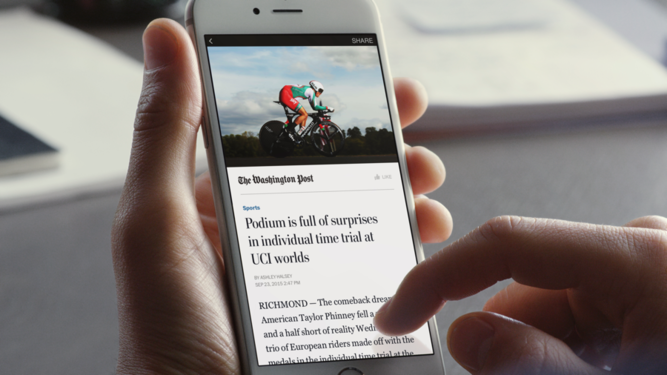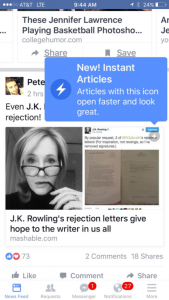Facebook Instant Articles: Should You Update Your Content Marketing Strategy?
Adapted from this article originally published on Business.com.
Content is king!
This well-worn marketing adage still reflects this fact about online marketing: content remains important and valuable for brands.
But now, we can replace that adage with “FAST loading content is king.” Back on April 12, Facebook officially rolled out Instant Articles for all users.
Instant Articles’ most obvious benefit is to increase speed of access to content. This lightening fast, mobile-only feature loads content up to 10 times faster than standard mobile web articles. Some other impressive stats? On average, 20 percent more Instant Articles are read than more non-Instant ones. Even more impressive—users are 70 percent less likely to abandon the article. WOW!
That means less friction in opening articles on the Facebook newsfeed, which makes it more likely that people check out the content and spend time with it.
How Much Does This Speed Advantage Matter to Brands?
Given the fact that 90 percent of Facebook’s monthly active users access the platform on mobile, it’s critical that brands and businesses understand the importance of speed.
According to online ecommerce solution, Shopify, in 1999 the average user was willing to wait eight seconds for a page to load. By 2010, 57 percent of online shoppers said they would abandon a page after three seconds. And 58 percent of mobile users say they expect their mobile website to load almost as fast to even faster than the experience they get on their desktop browser.
Content is becoming more and more visual, driven partly by its preferred treatment in Facebook’s algorithms but also by user preferences. As it does, Instant Articles’ advantages increase. Videos can be embedded in articles to autoplay. Maps and photos can be explored more interactively. And help is already here to create this visual content. Facebook has made Instant Articles available to mobile publishing platform Steller.
Everyone, including brands, can use Steller’s iOS mobile app for “telling your story with photos, video and text.” Voted Apple’s Best of 2014 app, it’s still free. Facebook has also arranged with WordPress to extend Instant Articles to anyone who runs a self-hosted WordPress site or pays for WordPress VIP using their new plugin.
The advantages for Facebook are clear. The faster more immersive experience of Instant Articles keeps users on Facebook, where they can see ads and connect with friends. The advantages for brands are that Instant Articles gives brands new ways to distribute branded content, connect with prospects, and convert them to buyers.
Instant Articles Can Include Sign Up Widgets
Organic reach for content on Facebook is hard to come by. Brands will likely continue to increase their Facebook ad spending to get their content in front of people, and features in the Instant Articles format makes that easier. For example, your content on Instant Articles can include widgets such as email newsletter signup forms.
Steller is developing new interactive widgets for Instant Articles that include a “Call Now,” “Reserve Now” (think hotels and restaurants), or “Schedule an Appointment” (many uses, all the way from wellness clinics to auto repair shops) button.
Steller is also working on custom themes for Instant Articles that allow a brand logo, colors, or font to be used in the content. You can then bring and build an integrated brand feel to your Facebook interactions with prospects and customers.
Placing Ads in Your Instant Articles
Facebook restricts how many ads publishers can show in Instant Articles. Currently, the 350 word/15 percent rule is in place. It means that each ad must be separated by at least 350 words. For articles that are primarily images or video, ads cannot exceed 15 percent of the content.
Content owners can monetize through direct sold ads and keep 100 percent of the revenue. Or ads through the Facebook Audience Network (a Google AdSense competitor) are also an option. Facebook is also rolling out Canvas, an all-new fully immersive mobile only ad unit.
Given how much Facebook users access the platform via mobile devices only, the faster and more attractive both content and ads, the more users will remain engaged. Plus, users will feel as though the content from brands isn’t as interruptive as the content from their friends when it includes attractive visuals, videos and interactive elements.
Here are some recent (January 2016) Facebook mobile stats:
- 47 percent of Facebook users login only from a mobile device
- 65 percent of Facebook videos take place on mobile devices
We as users are changing Facebook. With much of online content being viewed on mobile devices, speed of access, especially for visual and mixed media content becomes more important. Facebook is responding with user-friendly features, like Instant Articles.
Since Instant Articles was rolled out to iPhone users late last year, users have already reported a change in their behavior. They look for the little lightning-bolt icon in the upper corner that indicates an Instant Article post to decide whether to open a story.
We’ve certainly become less tolerant of slow-responding technology in recent years. Will Instant Articles further increase our desire for speed? Here’s another question: Will Instant Articles only be used for short-term content, designed to get a burst in brand interest, while content with long-term growth potential remains only on domains?
It’s a possibility and remains to be seen. A third big question brands are asking: is the upside of Instant Articles enough to offset the downside of decreasing traffic where the content usually sits, on brand websites?
Facebook and the Future – a Mobile Operating System?
China’s wildly popular WeChat app is like a mobile operating system that is a powerful platform for commerce integration. It’s light years ahead of anything we have in North America currently. The only two apps poised to remotely compete are Facebook Messenger and WhatsApp (owned by Facebook).
Now, with Instant Articles in the mobile news feed, it seems clear where Facebook is heading: to create a Dzone-stop, mobile experience for the customer. So the answer to the question: will Instant Articles really change content marketing?
We will have to wait to see, but lightening fast speed plus commerce integration will certainly make it more enticing for brands and harder to ignore.


